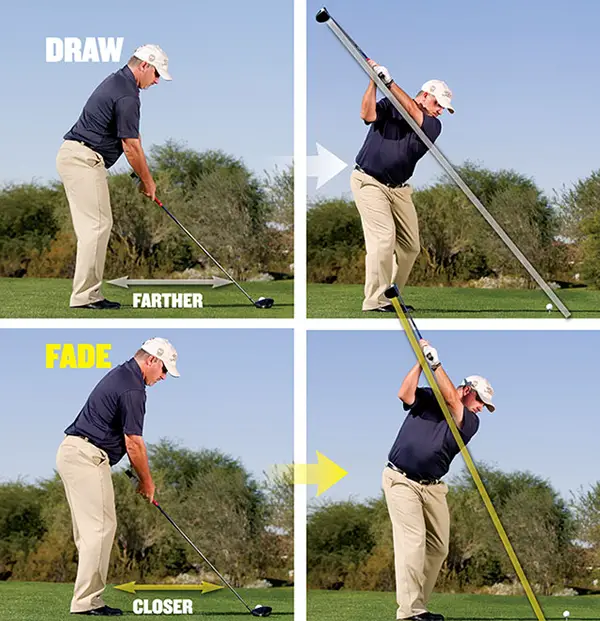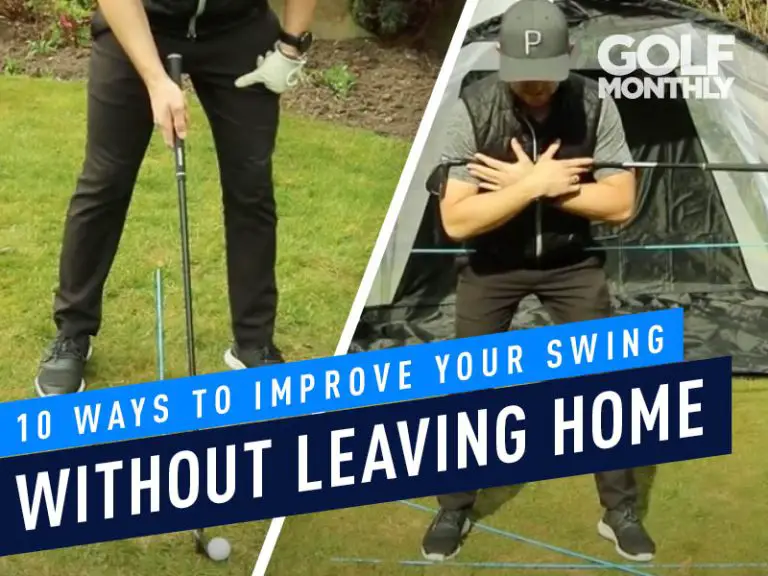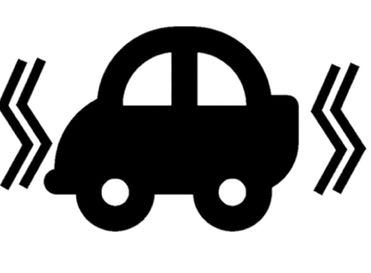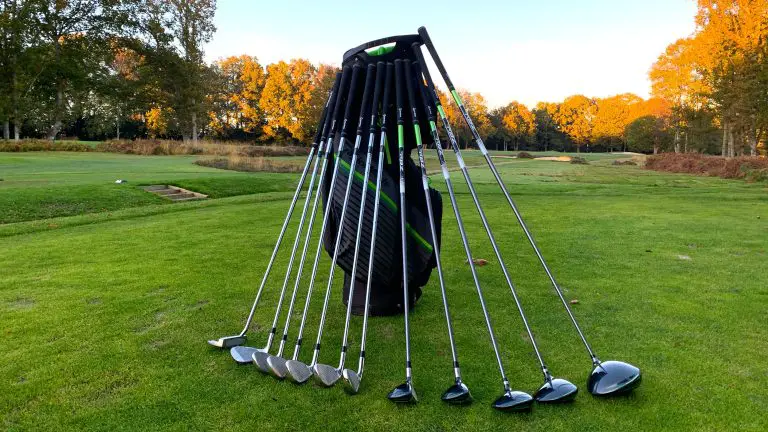How To Hit A Draw And Fade

In the game of golf, precision and control are paramount. As golfers strive to improve their performance, the ability to hit a draw or a fade becomes a coveted skill. These shot-shaping techniques allow players to navigate challenging fairways, avoid hazards, and strategically position their shots for optimal results.
Hitting a draw involves a gentle right-to-left curve (for right-handed golfers), adding distance and control to the shot. On the other hand, a fade showcases a subtle left-to-right curve, providing enhanced shot control and precision. Mastering these techniques empowers golfers to tailor their shots to match the demands of the course and overcome obstacles with finesse.
To achieve consistent draw and fade shots, it is essential to understand the mechanics and principles behind them. Proper setup, alignment, grip, swing path, and body rotation all play crucial roles in executing these shots effectively. By honing these skills and incorporating them into their repertoire, golfers gain a competitive edge, enabling them to conquer the course with confidence.
This comprehensive guide will delve into the intricacies of hitting a draw and fade in golf. We will explore the fundamental techniques, troubleshoot common mistakes, and provide practical tips for practice and on-course strategies. Whether you’re a beginner seeking to grasp the basics or an experienced player aiming to refine your shot-shaping abilities, this article will equip you with the knowledge and tools to take your game to new heights.

Understanding the Draw Shot
The draw shot is a powerful shot that curves gently from right to left (for right-handed golfers). It is a go-to shot for many players as it provides additional distance and control. Before diving into the mechanics, let’s understand the characteristics of a draw shot and how it differs from other types of shots.
A draw shot:
- Starts to the right of the target (for right-handed golfers) and curves left.
- Has a more pronounced left-to-right spin (topspin) that helps the ball roll farther upon landing.
- Provides added carry and distance due to the ball’s initial launch angle.
Setup and Alignment
Proper setup and alignment are fundamental to executing a draw shot successfully. Pay attention to the following aspects:
- Grip and Hand Position: To encourage a draw, slightly rotate your hands clockwise on the grip (for right-handed golfers). This promotes a closed clubface at impact, which helps impart the desired left-to-right spin on the ball.
- Addressing the Ball: Align your body parallel to the target line, but slightly adjust your feet, hips, and shoulders to the right (for right-handed golfers). This closed stance helps you swing along an inside-out path, creating the necessary right-to-left spin.
- Clubface Position: Position the clubface slightly closed at address, aiming to the right of the target (for right-handed golfers). This initial clubface alignment sets the foundation for the desired draw trajectory.
Swing Mechanics for a Draw Shot
Executing the correct swing mechanics is vital to achieving a consistent draw shot. Focus on the following elements:
- Initial Swing Path and Clubface Position: During the backswing, aim to swing the club along an inside-out path, tracing a slight arc. Simultaneously, maintain a slightly closed clubface position throughout the swing. These factors combine to produce the desired draw spin.
- Proper Body Rotation and Weight Transfer: Engage your body rotation smoothly throughout the swing. Initiate the downswing by shifting your weight onto your front foot and rotating your hips and torso through impact. This sequence helps deliver the clubface square to the target at the point of contact.
- The Role of Hands and Wrists: To enhance the draw effect, focus on maintaining a strong grip pressure throughout the swing. This ensures that the clubface remains slightly closed relative to the swing path, promoting the desired left-to-right spin.
Common Draw Shot Mistakes and Troubleshooting
While learning to hit a draw, it’s common to encounter some challenges. Let’s explore a few common mistakes and how to troubleshoot them:
- Overdoing the Draw and Creating a Hook: Sometimes, golfers inadvertently exaggerate the draw spin, leading to a hook—a shot that curves excessively from right to left. To prevent this, be mindful of your grip pressure and avoid excessive manipulation of the clubface during the swing.
- Slicing the Ball Instead of Drawing It: In the process of trying to hit a draw, golfers may end up slicing the ball—causing it to curve excessively from left to right. To correct this, double-check your setup and make sure your body alignment is adjusted properly. Additionally, focus on maintaining a balanced and controlled swing tempo, allowing the clubface to square up at impact.
- Correcting Alignment and Swing Faults: If you consistently struggle with hitting a draw, consider seeking guidance from a golf instructor or coach. They can help identify any alignment or swing faults that may be hindering your ability to execute the shot effectively. Professional feedback and personalized instruction can greatly accelerate your progress.
Perfecting the Fade Shot
Understanding the Fade Shot
In contrast to the draw shot, the fade shot curves gently from left to right (for right-handed golfers). It is a valuable tool in a golfer’s arsenal, particularly when navigating tight fairways or strategically positioning shots. Let’s dive into the characteristics and benefits of the fade shot.
A fade shot:
- Starts to the left of the target (for right-handed golfers) and curves right.
- Has a more pronounced right-to-left spin (backspin) that helps the ball stop quicker upon landing.
- Allows for enhanced shot control and precision when approaching greens.
Setup and Alignment
To consistently execute a fade shot, proper setup and alignment are crucial. Consider the following aspects:
- Grip and Hand Position: When setting up for a fade, slightly rotate your hands counterclockwise on the grip (for right-handed golfers). This promotes a more open clubface at impact, encouraging a left-to-right ball flight.
- Addressing the Ball: Align your body parallel to the target line, but slightly adjust your feet, hips, and shoulders to the left (for right-handed golfers). This open stance facilitates an outside-in swing path, generating the desired left-to-right spin.
- Clubface Position: Position the clubface slightly open at address, aiming to the left of the target (for right-handed golfers). This initial clubface alignment establishes the foundation for the intended fade trajectory.
Swing Mechanics for a Fade Shot
To consistently produce a reliable fade shot, focus on the following swing mechanics:
- Initial Swing Path and Clubface Position: During the backswing, aim to swing the club along an outside-in path, tracing a shallow arc. Concurrently, maintain a slightly open clubface position throughout the swing. These factors combine to generate the desired left-to-right ball flight.
- Body Rotation and Weight Transfer: Engage a controlled and fluid body rotation during the swing. Initiate the downswing by shifting your weight onto your front foot and rotating your hips and torso through impact. This sequence helps square the clubface at impact while imparting the desired fade spin.
- Utilizing the Hands and Wrists: To enhance the fade effect, pay attention to the grip pressure and allow for some freedom of movement in your hands and wrists. This promotes a more open clubface relative to the swing path, resulting in the desired left-to-right spin.
Common Fade Shot Mistakes and Troubleshooting
When learning to hit a fade shot, certain common mistakes can impede your progress. Let’s address a few of these mistakes and provide troubleshooting tips:
- Excessive Slicing Instead of Achieving a Fade: Sometimes, golfers unintentionally slice the ball instead of executing a controlled fade. This occurs when the ball curves excessively from left to right. To correct this, ensure your grip pressure is balanced, and focus on a smooth, controlled swing with proper body rotation.
- Hooking the Ball Instead of Fading It: In an attempt to hit a fade, golfers may inadvertently hook the ball, causing it to curve excessively from right to left. To prevent this, verify that your body alignment is correct, and maintain a balanced grip pressure throughout the swing. Additionally pay attention to the path of your swing, ensuring that it follows an outside-in trajectory to promote the desired left-to-right ball flight.
- Correcting Alignment and Swing Faults: If you find it challenging to consistently execute a fade shot, it can be beneficial to seek guidance from a golf professional. They can analyze your setup, alignment, and swing mechanics, offering specific recommendations tailored to your individual needs. Working with an instructor can help you identify and correct any alignment or swing faults that may be hindering your ability to achieve the desired fade shot.
Practicing and Fine-Tuning Shot Shaping
Developing Consistency in Shot Shaping
To become proficient in hitting draw and fade shots, consistent practice is essential. Here are some tips to help you develop and refine your shot-shaping abilities:
- Importance of Practice and Repetition: Allocate dedicated practice time to work on your draw and fade shots. Consistency and repetition will help develop muscle memory and improve your ability to execute these shots on demand.
- Incorporating Shot Shaping Drills: Include specific drills in your practice routine that focus on shot shaping. For example, you can set up targets at varying distances and practice hitting draws or fades to those targets. This targeted practice will enhance your ability to control the ball flight.
- Tracking and Analyzing Shot Patterns: Keep a record of your shots during practice sessions or rounds. By analyzing your shot patterns, you can identify trends, assess your progress, and make necessary adjustments to improve your shot shaping skills.
Understanding Ball Flight Laws
To gain a deeper understanding of shot shaping, familiarize yourself with the laws that govern ball flight. These laws explain the relationship between the clubface angle, swing path, and resulting ball flight. Key concepts to grasp include:
- Relationship Between Clubface Angle and Swing Path: The clubface angle relative to the swing path largely determines the initial direction and curvature of the ball flight. Understanding this relationship allows you to manipulate the clubface and swing path to produce specific shot shapes.
- Influence of Swing Path on Shot Shape: The path your club follows during the swing affects the direction of the ball flight. An inside-out swing path tends to produce draws, while an outside-in path tends to yield fades. By controlling your swing path, you can shape your shots accordingly.
- Applying Ball Flight Laws to Adjust Shot Shape: Armed with the knowledge of ball flight laws, you can make adjustments to your setup, grip, and swing to achieve the desired shot shape. For example, if you’re consistently hitting a draw when attempting a fade, you can tweak your grip or swing path to encourage the desired left-to-right ball flight.
Adjusting Equipment for Shot Shaping
Your equipment plays a role in shot shaping as well. Consider the following factors when it comes to adjusting your equipment for optimal shot shaping:
- Club Selection and Shot Shape: Different clubs can influence shot shape to some extent. For instance, a lower lofted club like a driver may naturally produce less backspin, making it more conducive to hitting fades. Experiment with different clubs to identify those that align with your desired shot shapes.
- Modifying Equipment Specifications: Equipment specifications, such as lie angle and shaft flex, can impact shot shape. Consulting with a professional club fitter can help you determine if any adjustments are needed to optimize your equipment for your desired shot shapes.
- Professional Fitting for Personalized Adjustments: If you’re serious about shot shaping, consider getting a professional club fitting. A club fitting expert can analyze your swing and provide recommendations on clubhead design, shaft characteristics, and other customization options to enhance your shot shaping abilities.
On-Course Strategies and Shot Selection
As you take your shot shaping skills onto the course, it’s important to develop effective strategies and make informed shot selections. Consider the following:
- Assessing Course Layout and Shot Requirements: Take time to analyze the course layout, including the placement of hazards, doglegs, and green complexes. Identify specific holes or situations where shot shaping can provide a strategic advantage. Understanding the course’s demands will help you make better shot selections.
- Making Informed Decisions Based on Shot-Shaping Abilities: Consider your skill level and confidence in executing draw and fade shots when making shot selections. If you’re more comfortable with a draw, look for opportunities to utilize it on holes that suit your shot shape. Conversely, if you have a reliable fade, take advantage of holes that favor that shot.
- Adapting to Changing Conditions and Shot Challenges: Golf is a dynamic game, and conditions can vary from round to round. Adaptability is key. Assess factors such as wind direction, speed, and course conditions to determine the optimal shot shape for each situation. Adjusting your strategy based on these variables will help you navigate challenges effectively.
Remember, shot shaping is a skill that develops over time. It requires practice, patience, and a willingness to experiment. As you continue to refine your ability to hit draws and fades, you’ll gain greater control over your ball flight, ultimately improving your overall performance on the golf course.
Conclusion:
Mastering the art of shot shaping is a valuable asset for any golfer. The ability to hit draws and fades opens up a world of possibilities when it comes to course management and shot selection. By understanding the mechanics, practicing diligently, and adapting to different situations, you can take control of your shots and add a new level of skill and finesse to your game. Embrace the challenge, invest in your development, and enjoy the rewards that come with mastering the draw and fade shots in golf.





